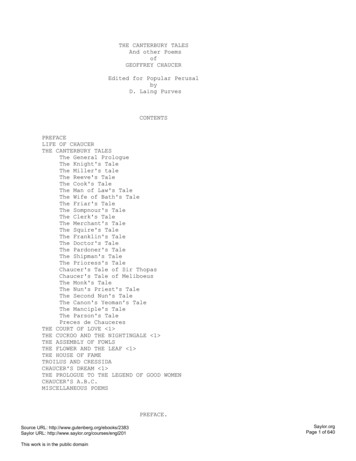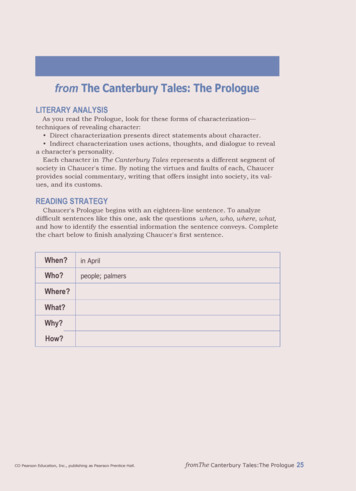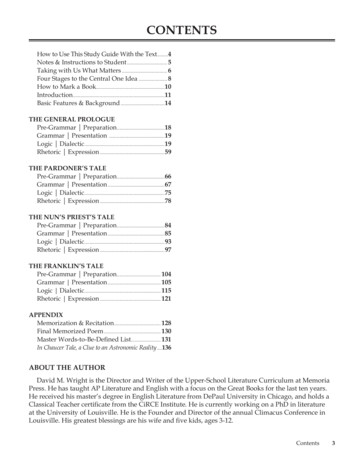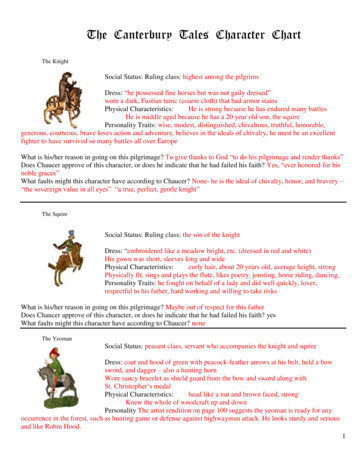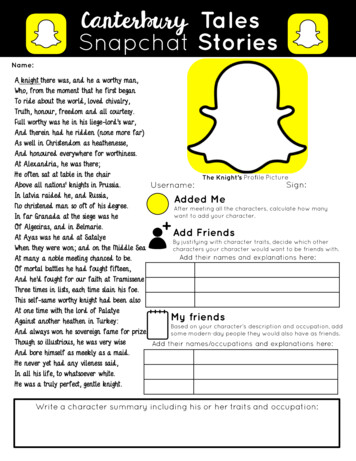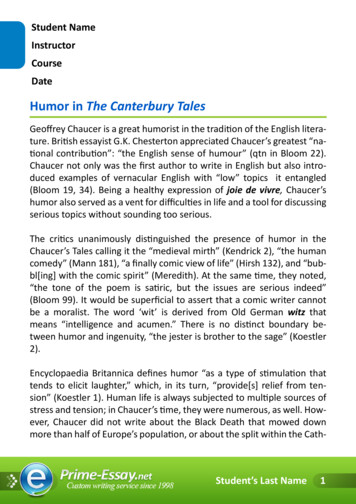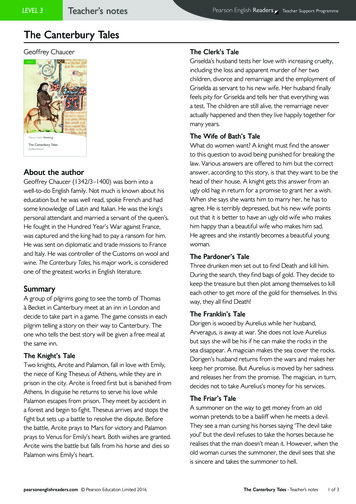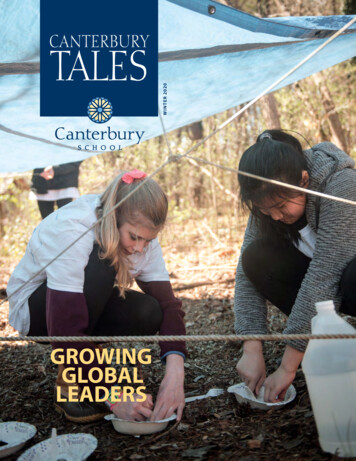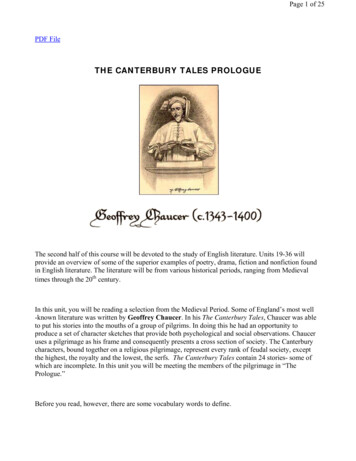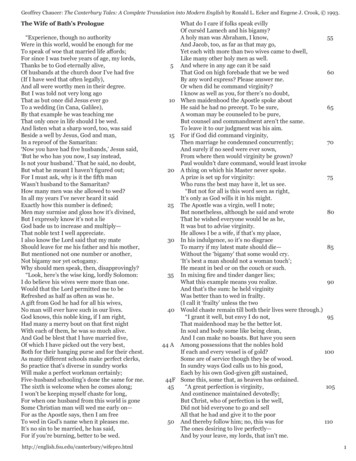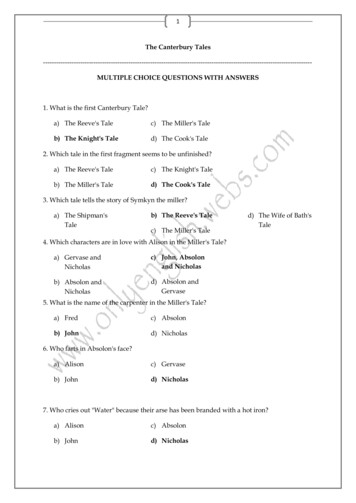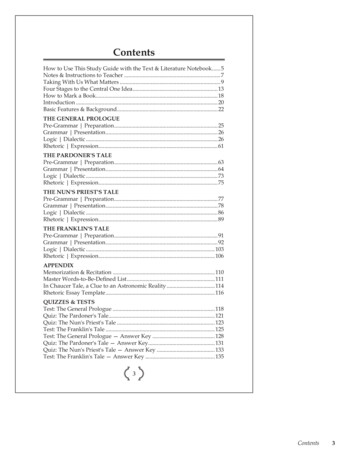
Transcription
ContentsHow to Use This Study Guide with the Text & Literature Notebook .5Notes & Instructions to Teacher .7Taking With Us What Matters .9Four Stages to the Central One Idea.13How to Mark a Book.18Introduction .20Basic Features & Background .22THE GENERAL PROLOGUEPre-Grammar Preparation .25Grammar Presentation .26Logic Dialectic .26Rhetoric Expression .61THE PARDONER'S TALEPre-Grammar Preparation .63Grammar Presentation .64Logic Dialectic .73Rhetoric Expression .75THE NUN'S PRIEST'S TALEPre-Grammar Preparation .77Grammar Presentation .78Logic Dialectic .86Rhetoric Expression .89THE FRANKLIN'S TALEPre-Grammar Preparation .91Grammar Presentation .92Logic Dialectic .103Rhetoric Expression .106APPENDIXMemorization & Recitation .110Master Words-to-Be-Defined List .111In Chaucer Tale, a Clue to an Astronomic Reality .114Rhetoric Essay Template .116QUIZZES & TESTSTest: The General Prologue .118Quiz: The Pardoner's Tale.121Quiz: The Nun's Priest's Tale .123Test: The Franklin's Tale .125Test: The General Prologue — Answer Key .128Quiz: The Pardoner's Tale — Answer Key.131Quiz: The Nun's Priest's Tale — Answer Key .133Test: The Franklin's Tale — Answer Key .1353 Contents3
Notes & Instructions to Teacher This Study Guide is intended to be used with the book, The Canterbury Tales: The General Prologue &Three Tales (a Reader-Friendly Edition in the original words put into modern spelling, edited andcopyright by Michael Murphy), published by Memoria Press (ISBN: 978-1-5477-0206-0). This Study Guide is best used in conjunction with a good-quality notebook, which will henceforthbe called the Literature Notebook. Most of the activities in this guide will be expected to becompleted in the Literature Notebook. And of course, the Literature Notebook will be the place forall of the student's notes during reading and discussion, and for all of the student's essays. Though I recommend that, ideally, your students complete the entire Study Guide in conjunctionwith reading and discussing the text, as a teacher myself, I also recommend that you adapt theStudy Guide to your particular context. This means you should feel comfortable using the StudyGuide to best suit the needs of you and your student(s)—in a manner that fits your family or classsize, schedule, number of meetings per week, time for grading, time allowed for discussion, andtotal time for the unit, etc. This may mean that you will choose to assign fewer vocabulary wordsand questions, etc. This is fine, and I encourage it. I have written the guides comprehensively toprovide a maximum number of notes, words, and questions, so that you will be able to assignfewer if need be, rather than wishing there were more. This Study Guide is written in such a way that it can be used for grades 8-12. If you are using it with8th and 9th graders, additional guidance, assistance, and adaptation will be helpful. Particular points in the text will be cited by line number. Michael Murphy retains the original linenumbers of the scholarly Riverside edition, which is arranged according to the fragments A, B, C,etc. Therefore, the line numbers will not correspond across the tales, just within each tale. The Introduction in the Study Guide, pp. 20-21, covers the introductory material in the text. Ofcourse it is good to assign all of the questions to the students, but please feel free to assign fewerif you choose. Another fine option would be to complete this section orally in class discussion, ingroups, or in another manner that suits your judgment. Students may also answer these questionsin their Literature Notebooks. You will notice that many questions ask the student to quote a line(s) from the text in his answer.This will help develop the student's ability to find evidence in the text to support his answer. Itwill also develop the skill of synthesizing quoted material into his written argument, which is animportant skill for analytical essay writing. The Reading Notes section contains some helpful notes and facts along with some of the difficultwords and phrases. Most of the archaic and challenging words are explained in the marginalglosses of Murphy's reader-friendly edition; thus, the Reading Notes will feature just some of thewords, not all. The Words to Be Defined section contains specific words chosen because they are both challengingand useful for the student to learn and memorize. Arcane or obscure Chaucerian words not inuse anymore are not selected. As well, with a few of the words, I have altered the spelling justslightly from the way it appears in the text—so that the student will memorize the most usefulform of the word. All italicized summaries of the tales in the Reading Notes are direct quotes from Michael Murphy'sitalicized summaries in the text.Notes & Instructions to Teacher7
Some of the essay prompts tend toward a shorter essay, and some toward a longer. Both shortessays (1 page) and long essays (2-4 pages) are useful and helpful, depending on the intent andpurpose. Convey your expectations regarding length to your student(s). A Rhetoric Essay Template is provided in the back of the Study Guide as another pre-writingoption to help students outline their essay before they undertake to write it. The template is verysimilar to the Rhetoric Expression section that students complete in their Literature Notebook,but the template provides a worksheet layout. You may choose to have students complete theRhetoric Expression section or use the template (photocopying the template as needed). In the Comprehension and Socratic Discussion Questions, I sometimes use the words "paraphrase,""summarize," or "provide a brief summary." All of these essentially mean the same thing. As a kind of "final achievement" that celebrates the reading of the text and completion of the StudyGuide, have your student(s) (or child) complete the Memorization & Recitation section at the endof the Study Guide. Perhaps more importantly, this section allows the student to move on from thepoem with a special part of The Canterbury Tales in her heart.8Notes & Instructions to Teacher
WORDS TO BE DEFINED1.cheerful2. mudTHE NUN'S PRIEST'S TALE Grammar Presentation3. a loverWORDS TO BE DEFINED4. filled with horror or shockNote: With a few words below, I have altered the spelling justslightly from the way it appears in the text, so that you willmemorize the modern spelling of the word.5. plentiful; ample6. fever; illness7. many thanks8. a gathering; crowd9. revenge10. ripped; tore11. oppose; resist12. learning; knowledgeDefinitions Bankangry disagreement; quarrellearning; knowledgecareless; neglectfullisten; give attention tocelebration; merrimenta lovercheerfulmany thanksdeceive; deludemud13. celebration; merrimentdevil; evil spiritoppose; resist14. wickedness; sinfulnessfever; illnessplentiful; ample15. angry disagreement; quarrelfilled with horror or shockrevenge16. devil; evil spirita gathering; crowdripped; tore17. listen; give attention tohigh-pitched, piercing in soundwickedness; sinfulness18. high-pitched, piercing in sound19. deceive; delude20. careless; neglectful1. Such thing is gladsome, as it thinketh me (3968)2. Although the slough had never been so deep. (3988)3. Which were his sisters and his paramour(s) (4057)COMPREHENSIONQUESTIONS4. She was aghast, and said: "O heartė dear (4079)1.5. When humours be too abundant in a wight. (4115)He says that heaviness (tragedies)is right enough for most people, butfor him it is "great dis-ease" to hearof men who have "been in greatwealth and ease" and then suddenlyhave a tragic fall. He'd rather hearthe contrary—of those who havebeen in "poor estate" and climb upto prosperity. (3959ff.)2. The Host calls him "Sir John,"a rather contemptuous way ofdesignating a priest. And he alsomakes fun of his skinny and dirtyhorse, "though thou ride upon ajade./What though thine horse bebothė foul and lean" (4002-4003).6. Or an ague that may be your bane. (4150)7. "Madame," quod he, "gramercy of your lore (4160)8. Where as there was such congregation (4178)9. Vengeance and justice of this felony (4230)10. But casually the ship's bottom rent (4291)11. I them defy, I love them never a deal. (4346)12. He knew by kind, and by none other lore (4386)13. Full is mine heart of revel, and soláce (4393)14. A coal fox, full of sly iniquity (4405)15. That in school is great altercation (4427)3. The poor country widow who ownsthe roosters84The Nun's Priest's Tale Grammar Presentation84
THE NUN'S PRIEST'S TALE Grammar Presentation16. Now certės, I were worsė than any fiend (4476)17. Was only for to hearken how you sing (4480)18. Ne made never shoutės half so shrill (4585)19. If thou beguile me oftener than once. (4618)20. And negligent, and trust in flattery. (4627)The Nun's Priest's Tale, marking the text in key Readplaces according to the method taught in "How to Marka Book."COMPREHENSION QUESTIONS1. What is the specific reason that the Knight gives for notwanting to hear any more stories with tragic endings?Quote a phrase or line from the text in your answer.2. From lines 3998ff., what is one of the comments by the Hostin which he makes fun of the Nun's Priest? Quote a phraseor line from the text in your answer.3. In patience led a full simple life,For little was her chattel and her rent.By husbandry of such as God her sentShe found herself, and eke her daughters two. (ll. 4016-4019)This quote is speaking of whom?4. Identify two similes in the description of Chanticleer inlines 4037ff.5. Provide a brief description of Pertelote. Quote a phrase inyour answer.6. From the "The cock's favorite wife, Pertelote" section (lines4055-4071), quote the particular line (or two) that articulatesthe beast fable genre.7. Describe Pertelote's reaction to Chanticleer's dream. Quote aline or two from the text in your answer. Do you agree withher reaction? Why or why not?8. What is Pertelote's diagnosis of dreams? In other words,what does she say dreams are caused by?4. Here are three, though there areseveral: "His voice was merrier than the merryorgan" (4041) "Well sikerer was his crowing in hislodge,/Than is a clock, or any abbeyorloge." (4043-4044) "And like the burnėd gold was hiscoloúr." (4054)5. She has the prettiest-coloredthroat. She is sociable and elegantin manner: "compaignable, andbore herself so fair" (4062). Also"Courteous she was, discreet, anddebonair" (4061).6. "For thilkė time, as I haveunderstand/Beastės and birdėscouldė speak and sing." (4070-4071)7. She is shocked and ashamed, andberates him rather severely. Shesays, "Avoy! fie on you, heartless"(4098). She also says he has nowlost her heart and her love, andthat she "cannot love a coward, bymy faith" (4101). Answers will varyregarding her reaction. It is fairlyeasy to assume we would reactdifferently considering we knowthat the fox does come and snatchhim away, thus revealing the dreamto in fact be prophetic. But if we arehonest, most of us would probablybe as skeptical as Pertelote!8. She says they are caused by anexcess of eating and drinking—"Swevens engender of repletïons"(4113); and that they are causedby the imbalance of the humors inthe body—"When humours be tooabundant" (4115).85The Nun's Priest's Tale Grammar Presentation85
9. Answers will vary. First she says tobeware of the noonday sun. Thenshe prescribes many medicinalherbs, such as "laureole, centaury,and fumetere,/Or else of helleborethat groweth there,/Of catapuce, orof gaitre-berries" (4153-4155).10. He says that many men, of moreauthority than Cato, have founddreams to be highly significant,and have proved them by theirexperience. "Than ever Cato was, somay I thee,/That all the reverse say ofthis senténce,/And have well foundenby experience,/That dreames besigníficatïons" (4166-4169).11. Two comrades go on a journey,have to stay in separate hostels,and one dreams that the other willbe murdered, which turns out to bewhat happens.Two sailors are about to sail; onedreams that if they sail the next day,they will be drowned. His fellowsailor sails anyway and his ship goesdown at sea.12. Answers will vary. In the OldTestament, the dreams of Daniel,Joseph, and the Pharaoh; Croesus,King of Lydia; and "Andromache,Hector's wife,/That day that Hectorshouldė lose his life" (4331-4332).13. 4416-442014. mock-heroic or comic irony15. Flattery and praise for Chanticleer'ssinging. He appeals to Chanticleer'spride. Any number of lines could bechosen: "Save you, ne heard I neverman yet sing/As did you father in themorwening" (4491-4492).16. He tempts the fox to turn aroundand verbally taunt his pursuers,thereby releasing Chanticleer whenhe opens his mouth.86THE NUN'S PRIEST'S TALE Logic Dialectic9. What are some of her prescriptions for the health problems?10. In the "Chanticleer's justification of the value of dreams" section(4160-4172), how does Chanticleer introduce his refutatio,his rhetorical refutation to Pertelote's argument? Quote aline or two from the text in your answer.11. What two anecdotes does Chanticleer tell to argue for thesignificance of dreams (through 4294)? Summarize each onein a sentence or two.12. List two shorter examples provided by Chanticleer in whichdreams foretold disaster. Quote a line from the text in one.13. In lines 4405-4423, which lines feature anaphora?14. The barnyard animals discussing lofty philosophical andtheological subjects is an example of what literary style?15. What is the fox's primary means of manipulating Chanticleer?Quote a line or two from the text in your answer.16. In a surprising peripeteia, how does Chanticleer outsmartthe fox?LOGIC DialecticThe student reasons with the facts, elements, and features ofthe poem; sorts, arranges, compares, and connects ideas—andbegins to uncover and determine the Central One Idea.SOCRATIC DISCUSSION QUESTIONSMay be verbally discussed or answered in written form in yourLiterature Notebook.1. Describe some of the imagery of the poor country widow.What details reveal that she is poor? Quote a phrase or linefrom the text in your description.2. Do you think Chaucer intends a kind of irony bycontrasting the poor widow with her splendid, "crowing"Chanticleer and Pertelote? What two social worlds mightthe widow and the hens symbolize?3. Describe some of the imagery in Chanticleer's dream. Doyou think his dream has a prophetic sense about it? Explain.The Nun's Priest's Tale Logic Dialectic86
THE NUN'S PRIEST'S TALE Logic DialecticSOCRATIC DISCUSSIONQUESTIONS1.4. Write a fairly general outline of Chanticleer's rhetoricalargument for the significance of dreams (ll. 4160-4361).Use a traditional alphanumeric outline with major pointsand subpoints (Roman numerals, capital letters, numbers,and lowercase letters, etc.). Outlines vary widely, as theyare written according to the nature of the content beingoutlined. With respect to your time, your outline here maybe more general, rather than detailed and specific. If youwish, you may use some of Murphy's italicized headings inyour outline, or to help you conceive your outline. Here is asection of an outline to serve as a brief example:Traditional Poetic FormsI. The VillanelleA. Formal Characteristics1. 19 lines2. 6 stanzas—5 stanzas with 3 lines, and the last with4 lines3. The first line of the first stanza is repeated as the lastline of the second and fourth stanzas.4. The third line of the first stanza is repeated as thelast line of the third and fifth stanzas.5. The rhyme scheme is aba.B. Notable Villanelles1. "The House on the Hill," Edward Arlington Robinson2. "The Waking," Theodore RoethkeII. The SonnetA. Formal CharacteristicsAnswers will vary. She is advanced inage, "dwelling in a narrow cottáge"(4012). She leads a patient, "fullsimple life" (4016). "Full sooty was herbower, and eke her hall" (4022)—Thesootiness belongs to the peasant life,rather than the life of the rich. Shedoes not eat fancy meats or daintymorsels, and thus has no need forpoignant sauces. She lives modestlyand eats temperately. She is contentand peaceful.2. Yes, Chaucer intends his contrastto create irony and to serve as acommentary on both the rich andthe poor. The widow represents thepoor, and Chanticleer and Perteloterepresent the rich. He considers eachclass ironically, but clearly the rich(Chanticleer and Pertelote) receivethe most ironic, sarcastic treatment.3. He dreamt that he was roamingup and down the yard. He sees a"beast" in the yard "like a hound."The beast's "colour was betwixtėyellow and red;/And tippėd was histail, and both his ears/With black"(4092-4094). The beast has a"snoutė small, with glowing eyentway" (4095). Yes, his dream hasa foreboding, ominous propheticsense—in particular because ofthese lines: the beast "would havemade arrest/Upon my body, andhave had me dead" (4090-4091);and "Yet of his look for fear almost Idie" (4096).4. Chanticleer's ArgumentI. IntroductionA. Chanticleer's Justification of the Significance of Dreams1. Many men of more authority than Cato held the opposite view.II. Support - Anecdotes and ExamplesA. Two fellows on a pilgrimageB. ExclamatioC. Two sailors about to set out to sea1. Doomed sailor's refutation against the significance of dreams87D. Chanticleer's Mini-Conclusion1. In light of these anecdotes, no man should be too contemptuous of dreams.E. St. Kenélm's dream of his own murderF. A series of shorter examplesIII. Major ConclusionA. My dream forebodes adversity.B. I do not want or trust your laxatives.C. Let's speak of fun things and stop this disagreement.D. Pertelote, you're beautiful!The Nun's Priest's Tale Logic Dialectic87
Notes & Instructions to Teacher This Study Guide is intended to be used with the book, The Canterbury Tales: The General Prologue & Three Tales (a Reader-Friendly Edition in the original words put into modern spelling, edited and copyright by Michael Murph
